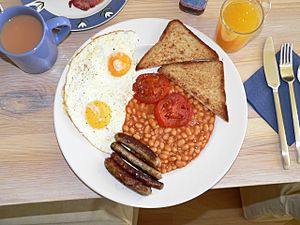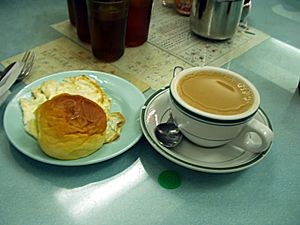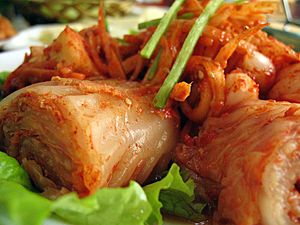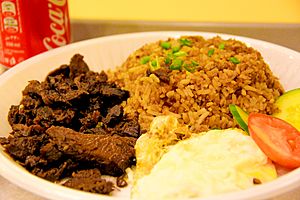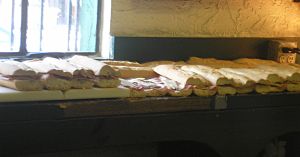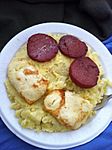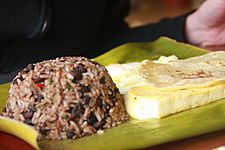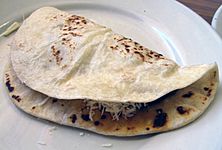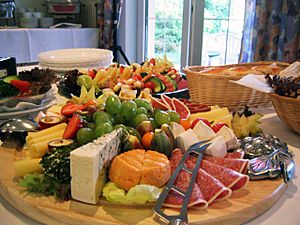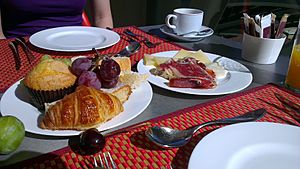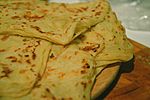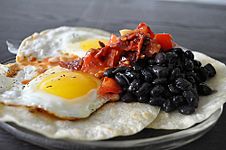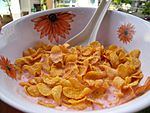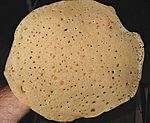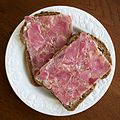Breakfast facts for kids
Breakfast is the very first meal you eat in a day. It's usually enjoyed in the morning. The word "breakfast" comes from two older words: "break" (meaning to end) and "fast" (meaning not eating for a long time). So, it literally means to "break the fast" from not eating all night!
People all over the world eat different and exciting things for breakfast:
- In England, people often have a big breakfast. This can include bread, tea, eggs, bacon, ham, fruits, baked beans on toast, and sometimes vegetables.
- In France, people usually eat a very light meal. They often have bread and coffee with milk.
- In Asia, many people eat rice instead of bread. They also sometimes enjoy porridge.
Contents
- The History of Breakfast
- Breakfast Around Asia
- Breakfast in the Caribbean
- Breakfast in Central America
- Breakfast in Europe
- Albania's Morning Meal
- Croatia's Breakfast Choices
- Denmark's Breakfast Habits
- Finland's Simple Breakfast
- France's Sweet Start
- Germany and Austria's Breakfast Spread
- Greece's Morning Habits
- Hungary's Big Breakfast
- Italy's Sweet Start
- Latvia's Light and Salty Breakfast
- Malta's Mixed Breakfast
- Netherlands' Topping Choices
- Norway's Open Sandwiches
- Poland's Big Breakfast Spread
- Romania's Breakfast Habits
- Russia's Porridge and Pancakes
- Serbia's Morning Meals
- Southeastern Europe's Pastries
- Spain's Sweet and Savory Options
- Sweden's Open-Faced Meals
- Switzerland's Muesli
- Turkey's Rich Breakfasts
- United Kingdom and Ireland's Full Breakfast
- Breakfast in the Middle East and North Africa
- Breakfast in North America
- Breakfast in Oceania
- Breakfast in Sub-Saharan Africa
- Images for kids
- See also
The History of Breakfast
The idea of breakfast has changed over time. The Old English word for dinner, disner, actually meant the first meal of the day, which broke a fast. This meaning changed around the 1200s. It wasn't until the 1400s that the word "breakfast" started being used in English to describe the morning meal. Before that, in Old English, it was called morgenmete, which simply means "morning meal."
Breakfast Around Asia
Myanmar's Morning Meals
In Myanmar (formerly Burma), a common breakfast is htamin jaw. This is fried rice with boiled peas (called pè byouk). People often drink yei nway jan (which is green tea) with it, especially if they don't have much money.
Another popular choice is kao hnyin, which is glutinous rice steamed and wrapped in a banana leaf. It's often served with peas and a sprinkle of salted sesame seeds. A purple kind of rice called nga cheik is cooked the same way. Si damin is sticky rice cooked with turmeric and onions in peanut oil. It's served with salted sesame and crispy fried onions. Small fried snacks called fritters, like baya jaw (made from urad dal), are often eaten with these meals.
Nan bya or naan (flatbreads like those from India) are also eaten with pè byouk or just butter. People drink Indian tea or coffee with them. They go well with hseiksoup (mutton soup).
Fried chapati bread, which is crispy, is another favorite. It's eaten with pè byouk and crispy fried onions. Htat ta ya, meaning "a hundred layers," is a flaky, layered fried bread called paratha. It's served with pè byouk or a sprinkle of sugar.
Eeja gway (Chinese-style fried breadsticks, also known as youtiao) with Indian tea or coffee is another popular choice.
Mohinga is perhaps the most famous breakfast in Myanmar. It's a noodle dish with rice vermicelli in a fish broth. The broth is thickened with chickpea flour or crushed toasted rice. It also has lemon grass, sliced banana stem, onions, garlic, ginger, pepper, and fish paste. It's served with crispy fried onions, dried chili, coriander, fish sauce, and lime. You can add fritters, boiled eggs, and fried fish cake to it.
Chinese Breakfast Choices
Mainland China has many different provinces, and each has its own special food. So, breakfast in China can be very different depending on where you are. Generally, common choices include sweet or salty pancakes, soup, deep-fried bread sticks or doughnuts (youtiao), buns (mantou), porridge (congee), and fried or soup-based noodles. These are often served with tea or sweet soy bean milk. However, the toppings for porridge and the soup bases change from one region to another. The types of teas and spices also vary a lot.
Hong Kong's Morning Mix
Hong Kong was a British colony for a long time and is close to China's Canton region. Because of this, both English and traditional Cantonese breakfasts are popular. There's also a mix of both, often found in places called Cha chaan teng. These breakfasts often include Hong Kong-style milk tea, pan-fried eggs, bread, Cantonese noodles, or Hong Kong-style macaroni in soup.
Traditional Cantonese breakfast might include dim sum. These are small dishes with many different ingredients, prepared in various ways. They can be delicate steamed dumplings with shrimp or sweet water chestnut cake. Each dish is meant to be tasted, and people can try many different dim sum quickly, along with plenty of good tea. Iron Buddha tea is the most common tea, but others like pu'er and oolong are also popular. Fried and rice-based noodles and cakes are also common. Today, dim sum is usually made and served in Yum Cha restaurants because it takes a lot of skill and effort to prepare at home.
Japanese Breakfast Styles
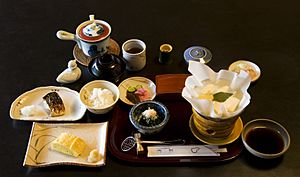
In modern Japanese homes, breakfast comes in two main types: Japanese style and Western style. Japanese-style breakfasts are eaten widely, but often only on weekends or days off. Younger Japanese couples might prefer Western-style breakfasts because they are usually quicker to make.
A standard Japanese breakfast includes steamed white rice, a bowl of miso soup, and Japanese pickles (like takuan or umeboshi). A raw egg and nori (dried seaweed) are often served. The raw egg is beaten in a small bowl and poured over hot rice to make tamago kake gohan. The nori sheets are used to wrap rice. Grilled fish and Japanese green tea are also often served.
Western-style breakfasts in Japanese homes are similar to those in the United States. Japanese children often eat corn flakes and drink milk, hot chocolate, or fruit juice. Japanese adults (especially younger ones) tend to have toast with butter or jam, eggs, and sliced vegetables. They often drink coffee or orange juice.
Traditional Japanese inns (like ryokan) serve full traditional breakfasts. Hotels and restaurants in Japan usually offer a mix of Western and Japanese styles.
Korean Breakfast Dishes
Traditionally, Korean breakfasts mostly include rice and soup dishes. These can have small amounts of fish or beef, and some kind of broth, stew, or porridge. Like all Korean meals, breakfast is usually served with banchan, which are side dishes. These often include kimchi, Gyeran-jjim (steamed eggs), and tofu.
Indian Breakfast Varieties
India has at least 25 different types of breakfasts, with over 100 different food items! Each state in India has its own special breakfast foods. So, there isn't one standard Indian breakfast; the items change by region. However, you can generally divide Indian breakfasts into two main types: North Indian and South Indian. Eastern and Western India also have unique breakfast items.
A typical South Indian breakfast includes idli, vada, or dosa. These are usually served with chutney and sambar. There are many variations of these dishes, like Rava idli, thayir vadai (yogurt vada), sambar vada, and masala dosa. Other popular South Indian breakfast items are pongal, bisibelebath (sambar rice), upma, and poori. The state of Kerala has special breakfast items like appam, parotta, puttu, idiyappam, and palappam.
A typical North Indian breakfast might be a type of paratha or roti served with a vegetable curry, curd, and pickles. There are many kinds of parathas, depending on what they are stuffed with, such as aloo (potato) paratha, Paneer (cottage cheese) Paratha, or Mooli Paratha (Radish Paratha). Other popular breakfast items in the north are poori bhaji, poha, and bhindi bhujia.
In Bengal, roti and curry are common breakfast options. The menu might also include "Indian French toast" (also called "Bombay toast"), chire bhaja (flaked rice fried with oil and salt), and boiled eggs.
In Western India, a Gujarati home might serve dhoklas, khakhras, or theplas for breakfast. The most popular is methi thepla. In Mangalore, a special breakfast food called Oondees might be served.
In Maharashtra, a typical breakfast (Nashta) includes 'Kande Pohe', 'Upma', 'Ukkad', Thalipeeth, and 'Spiced Puree'. Sometimes 'Chapati Bhaji' or 'Chapati roll with tea' is eaten for breakfast.
Philippine Morning Meals
A traditional Filipino breakfast might include pandesal (small bread rolls), kesong puti (white cheese), champorado (chocolate rice porridge), sinangag (garlic fried rice), and meat. The meat could be tapa, longganisa, tocino, karne norte (corned beef), or fish like daing na bangus (salted and dried milkfish). Sometimes itlog na pula (salted duck eggs) are served. Coffee is also common, especially kapeng barako, a strong coffee from Batangas.
Filipinos use special portmanteau words to describe popular breakfast combinations. For example, kankamtuy means kanin (rice), kamatis (tomatoes), and tuyo (dried fish). Another is tapsi: tapa and sinangág. Other examples use a silog ending, which means some kind of meat served with sinangág (garlic fried rice) and itlog (egg). The three most common silogs are tapsilog (with tapa), tocilog (with tocino), and longsilog (with longganisa). Other silogs include hotsilog (with a hot dog), bangsilog (with bangus), dangsilog (with danggit), spamsilog (with spam), adosilog (with adobo), chosilog (with chorizo), chiksilog (with chicken), cornsilog (with corned beef), and litsilog (with lechon/litson). Pankaplog is a slang term for a breakfast of pandesal, kape (coffee), and itlog (egg). A restaurant that specializes in these meals is called a tapsihan or "tapsilugan."
Singapore's Kaya Toast
A traditional Singaporean breakfast includes kaya toast (bread with coconut milk jam), half-boiled eggs, and Kopi (coffee). Locals often dip the toast into the eggs mixed with soya sauce and pepper.
Breakfast in the Caribbean
Cuban Morning Flavors
In Cuban cities, breakfast usually means café con leche (coffee with milk) that is sweet and has a tiny bit of salt. Toasted, buttered Cuban bread, cut into pieces, is dipped into the coffee. In the countryside, farmers eat roasted pork, beans and white rice, café con leche, and cuajada (a type of cheese) sweetened with caramel.
Dominican Republic's Diverse Breakfasts
In the Dominican Republic, breakfast changes depending on the area. In the middle of the island, people often have vegetables with breakfast, especially green plantain. It's served boiled or mashed, known as Mangú.
In the capital city, breakfast is lighter. It includes coffee with milk or hot chocolate, along with bread, butter, and cheese. It's usually served with orange juice or other local fruit juices. Milk punch (milk, egg, nutmeg, and malt) and boiled eggs with "harina de negrito" (a type of cornstarch) are also eaten. A traditional breakfast bread is a water-based bread.
Jamaican Breakfast Delights
A Jamaican breakfast includes ackee and saltfish, seasoned callaloo, boiled green bananas, and fried dumplings.
Breakfast in Central America
Panama's Hearty Start
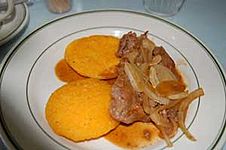
In Panama, breakfast is a big meal, especially in the countryside where people do hard work. It always includes black coffee (tinto) or coffee with milk (pintado). Sides can be corn tortillas, traditional white cheese (queso del pais), or "torrejas" made of wheat flour, known as "hojaldres." Another traditional breakfast side is "bollo" made from corn, white corn, or coconut. It's wrapped in corn leaves and can be "preña'o" (meaning "pregnant") if it's filled with meat.
For protein, a large serving of beef liver with onion, scrambled or fried eggs, beef stew, or "tasajo" (a type of beef jerky) are popular. Pork rinds and different kinds of sausages like chorizo or morcilla are also common. These are served with slices of green plantain or cooking plantain, "patacones" (double-fried plantain), carimañolas (yuca filled with meat), and various savory and sweet bread pastries.
These big breakfasts are usually for special occasions. Everyday breakfasts are more like Western meals, with toast, ham, cheese, and jam. The long presence of the US has also influenced cities in Panama, bringing meals like cereal with milk and pancakes with syrup as traditional breakfast options.
Costa Rica's Gallo Pinto
In Costa Rica, the most common breakfast is "gallo pinto." This dish is made from rice and beans (red or black) that were cooked earlier. They are then stir-fried in a pan with chile, onions, culantro (a local herb), and bean stock for color. It's served with fried egg, cheese, and fried plantain. Black coffee and coffee with milk are common drinks. In Limón Province, they make gallo pinto with coconut milk.
Another popular breakfast food is "chorreadas," which are savory sweet corn pancakes. They are usually served with cheese or a type of sour cream called "natilla."
Nicaragua's Morning Meals
In Nicaragua, a typical breakfast includes "gallo pinto" (the national dish made from red beans and rice), eggs, cheese, corn tortillas, and sweet plantains. Meals are usually served with different juices and coffee. On Sundays, nacatamales are the traditional breakfast. These are made of corn dough with rice, potatoes, pork or chicken, and sliced onions, all wrapped in plantain leaves. They are usually eaten with cacao as a drink.
Guatemala's Breakfast Plates
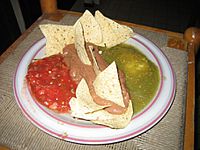
In Guatemala, breakfast includes one or two eggs, either fried, scrambled, or boiled, along with baked or fried beans and coffee. Fresh cream, fresh cheese, and fried plantains are also common. People often add hot sauce made from "chiltepes" (a type of pepper). These peppers are prepared raw or boiled, then ground with vinegar, chopped onions, and chopped cilantro to make the sauce. A traditional egg dish with both green and red sauces is called "huevos divorciados" (divorced eggs).
In the eastern part of the country, especially in Zacapa, you can find "huevos a caballo" (eggs on a horse). This is basically two fried eggs served over roasted steak.
Other breakfast options include milk cereals. The most common drinks are orange juice or other fruit juices, milk, atol (a milk pudding with chocolate), and cornstarch. Coffee is usually served with sweet bread, also called "pan de manteca" (butter bread).
Honduras' Breakfast Staples
In Honduras, people often start the day with homemade bread, coffee, or a glass of milk. Then, they have a plate of food with beans, eggs (scrambled or sunny side up), slices of fried plantain, corn, tortillas, cheese, and butter. Eggs can be prepared in different ways: "estrellados" (just cracked), in "torta" or omelet (beaten with salt), scrambled, or boiled. Another common breakfast is baleadas and tortillas with cheese. Sometimes they are fried together with cheese in between. In the "garífuna" culture, coffee is served with "mínimo" bread (banana bread) or coconut bread.
Breakfast in Europe
A typical Continental breakfast has coffee and milk (often mixed as Cappuccino or latte) or hot chocolate. It comes with various sweet cakes like brioche and pastries like croissant, often with jam, cream, or chocolate filling. Juice is also often served. Continental breakfasts can also include sliced cold meats, like salami or ham, and yogurt or cereal. Some European countries add fruit and cheese to the bread menu, and sometimes a boiled egg or a little salami.
Albania's Morning Meal
In Albania, breakfast often includes a scone, milk, tea, eggs, jam, or cheese. Meat is not usually eaten for breakfast. Instead, people might have seafood like canned sardines or tuna, often with mustard or mayonnaise. Whole-grain cereals and pastries are mostly eaten by children.
Croatia's Breakfast Choices
In Croatia, breakfast is usually a continental style. It includes various pastries with or without fillings (like marmalade, chocolate, cheese, ham, nuts, poppy). Fermented milk products like yogurt, soured milk, and soured cream are also popular. Cold cuts such as prosciutto, ham, salami, kulen, bacon, and different cheeses are also favorites. Fried eggs or omelets and Vienna sausage with mayonnaise, mustard, or ajvar are very often eaten. In the continental parts, sir i vrhnje (cottage cheese with soured cream and some spices) is traditional. Coffee is much more popular than tea (mostly herbal tea).
Denmark's Breakfast Habits
A typical breakfast in Denmark includes slices of rye bread (rugbrød) with yellow cheese, a soft-boiled egg, or sometimes ham, salami, or liver spread (leverpostej). It might also be breakfast cereals like oatmeal, corn flakes, or yogurt. White bread or bread rolls (rundstykker) with yellow cheese and different kinds of jams (usually berry or citrus) and other toppings are common, along with coffee or tea. On weekends or special days, people might have Danish pastries (wienerbrød), chocolate, or a bitters drink like Gammel Dansk.
Finland's Simple Breakfast
Breakfast in Finland usually consists of coffee or tea with open sandwiches. The sandwich often has butter or margarine, with toppings like hard cheese or cold cuts. Finns usually don't put sweet things like jam or chocolate on their bread. Sour milk products like yogurt or viili are also common breakfast foods. These are usually served in a bowl with cereals like corn flakes, muesli, and sometimes with sugar, fruit, or jam. Oatmeal or mixed grain porridge may also be served, usually topped with butter.
France's Sweet Start
In France, a typical breakfast at home includes a cup of coffee, often café au lait (coffee with milk), or hot chocolate. Sometimes, a glass of orange or grapefruit juice is added. The main food items are sweet, like tartines (slices of baguette or other breads spread with butter, jam, or chocolate paste). These are sometimes dipped in the hot drink. Brioches and other pastries like croissants, pains au chocolat, and pains aux raisins are also traditional, but more of a special treat for weekends. Other foods like breakfast cereals, fruit compote, fromage blanc, and yogurt are becoming more common. A traditional French breakfast doesn't include any savory foods, but hotel breakfast buffets often have ham, cheese, and eggs.
Germany and Austria's Breakfast Spread
A typical German breakfast includes bread or bread rolls, butter, jam, ham, cheeses, meat spreads, cold cuts, hard- or soft-boiled eggs, and coffee or tea. Cereals have become popular, and what people eat can be very different depending on the region. Yogurt, granola, and fruit (fresh or cooked) might also be served, as well as eggs cooked to order (especially in smaller hotels or bed-and-breakfasts). A second breakfast is traditional in some parts of Germany, especially in Bavaria, where it's called Brotzeit (meaning "bread time").
Greece's Morning Habits
Home breakfasts in Greece include bread with butter, honey, or marmalade with coffee or milk. Breakfast cereals are also eaten. Children often eat nutella-type cream on bread. It's also common for people to not eat breakfast at all. Various kinds of savory pastries (like Tyropita, spanakopita, and bougatsa) are also eaten for breakfast, especially by those eating out. These are usually served with Greek coffee or Frappé coffee.
Traditional Greek breakfast (hot milk, fresh bread, butter, and honey, or yogurt) used to be available in special "milk shops" (Galaktopoleia). These shops mostly disappeared between 1970 and 1990, and very few are left today.
Hungary's Big Breakfast
In Hungary, people usually have a large breakfast. Hungarian breakfast is generally an open sandwich with fresh bread or toast. It has butter, cheese, or different cream cheeses, túró cheese, or körözött (Liptauer cheese spread). Cold cuts like ham, liver pâté (called májkrém or kenőmájas), bacon, salami, beef tongue, mortadella, disznósajt (head cheese), and different Hungarian sausages or kolbász are common. Even eggs (fried, scrambled, or boiled), French toast called bundás kenyér, and vegetables (like peppers, tomatoes, radish, scallion, and cucumber) are part of the Hungarian breakfast. Sometimes breakfast is a cup of milk, tea, or coffee with pastries, bread rolls, or crescent-shaped bread (kifli), toast, pastries with different fillings (sweet and salty), butter, jam, or honey, and a bun or a strudel. Cereals like muesli and perhaps fruit are also eaten.
Italy's Sweet Start
The traditional breakfast in Italy is simply caffè latte (hot coffee with milk) with bread or rolls, butter, and jam. This is known as prima colazione or just colazione. Fette biscottate (a cookie-like hard bread often eaten with hazelnut chocolate spread or butter and jam) and biscotti (cookies) are commonly eaten. Hot coffee might sometimes be replaced by hot tea. Children often drink hot chocolate, plain milk, hot milk with barley coffee, or hot milk with very little coffee. Cereals, yogurt, and fruit juices are also common. If breakfast is eaten in a bar (coffee shop), it's usually a cappuccino and cornetto (frothed hot milk with coffee, and a pastry). It's not unusual for Italians to have a quick breakfast snack later in the morning.
Latvia's Light and Salty Breakfast
A typical Latvian breakfast usually includes open sandwiches with toppings made of vegetables, fish, eggs, or cheese. Like in Finland, it's often buttered with margarine. Curd mixed with vegetables and salt, as well as other sour milk products, are very popular. Light oat porridge is also often eaten. In general, light, sour, and salty foods are common for the morning meal. Latvians usually drink coffee for breakfast.
Malta's Mixed Breakfast
On the island of Malta, breakfast combines elements from both British and continental styles. Maltese people usually start their day with a bowl of cereal mixed with milk, sometimes with a cup of coffee or tea. Marmalade/jams or even chocolate spreads are also common on bread or toast. Today, cereal bars are also becoming a common breakfast choice. The traditional English breakfast of eggs, sausages, and fried bacon used to be popular, especially on Sundays, due to strong British influence. However, this has almost completely changed as locals now prefer a more Mediterranean and continental diet. Hotels usually serve both a continental and a full English breakfast. Prayers are often said before breakfast to bless the meal.
Netherlands' Topping Choices
For breakfast, the Dutch typically eat sliced bread with butter or margarine. They have three main choices for toppings: dairy products (many kinds of cheese), various cured and sliced meats, or sweet or semi-sweet products. These sweet options include jam, syrup (from sugar beets or fruit), honey, Kokosbrood (a thinly sliced coconut product), or peanut butter. Another type of sweet topping is chocolate. The Dutch have chocolate toppings in all forms: hagelslag (chocolate sprinkles), chocoladevlokken (chocolate flakes), and chocoladepasta (chocolate spread). Tea, dripolator coffee, milk, and juice are the most popular breakfast drinks. Breakfast might also include raisin bread and fried or boiled eggs. On special occasions like Easter or Christmas, breakfast is usually the same but with more choices, such as premium cheeses, special ham, hot buns, and croissants.
A 2012 survey found that the Dutch believe breakfast should be a more important meal and that more time should be spent on it. Almost three-quarters of those surveyed ate their sandwiches in less than fifteen minutes. They blamed "fast" breakfast products for this quick meal. A perfect "weekend breakfast" for the Dutch included coffee or tea, fresh-baked bread rolls (and croissants), and a boiled egg. The survey also found that men are more interested than women in having breakfast with their partner.
Norway's Open Sandwiches
80% of Norwegians eat breakfast every day, mostly at home. The most common breakfast is open sandwiches, often made with whole wheat bread. These sandwiches have cheese, often Jarlsberg, Norvegia, or brunost. Other toppings include cold cuts, leverpostei, jam, and more. Common drinks are water, various types of coffee like French press, cafe latte, or espresso, milk, and juice. Another common breakfast is breakfast cereals like corn flakes eaten with milk, kulturmelk, or yogurt. Whole-grain porridges with regular milk or butter are also eaten by some. Larger breakfasts might include fish, a variety of cheeses, eggs, bacon, breads, and hot and cold cereals eaten in different combinations. Pastries like croissants or pain au chocolat have become more common since the 1990s.
Poland's Big Breakfast Spread
The traditional Polish breakfast is a large spread with many different sides eaten with bread or toast. Sides include various cold cuts, meat spreads, the Polish sausage kielbasa, tomatoes, Swiss cheese, and sliced pickles. Twaróg, a Polish cheese, is a breakfast classic and comes in many forms. Twaróg can be eaten plain, with salt, sugar, or honey. It can also be mixed with chives to make a cream cheese-like spread. Eggs are often served as the main breakfast item, mostly soft-boiled or scrambled. For a quick winter breakfast, hot oatmeal, sometimes with cocoa, is often served. Jam spreads are popular for a quick breakfast, including plum, raspberry, and black or red currant spreads. Breakfast drinks include coffee, milk, hot cocoa, or tea. Traditionally, Poles avoid heavy-cooked foods for breakfast. You won't usually see fried meats or potatoes in a classic Polish breakfast. The focus is on a wide variety of foods to please everyone at the table.
Romania's Breakfast Habits
The traditional Romanian breakfast includes milk, tea, or coffee, along with (toasted) bread with butter or margarine. On top of the bread, people add honey or fruit jams or preserves. Sometimes, the buttered bread is savory instead of sweet, with cured meats, salami, or cheese. Another option is to spread liver pâté on a slice of bread. In recent years, Romanians have also started eating cereal with dried fruits and milk instead of the traditional breakfast, though this isn't yet very widespread. A 2014 study found that 35% of Romanians eat cooked dishes like omelets or fried eggs, and 15% eat sandwiches. Most people drink coffee, and 67% drink Turkish coffee (made in an ibrik), though more people are starting to use drip or filter coffee. While crêpes with fruit preserves, jams, or cheese have traditionally been desserts, more Romanians have started having them for breakfast on weekends.
Russia's Porridge and Pancakes
Traditional Russian breakfasts focus on kashas, or porridges. These are very important in Russian food culture. Buckwheat, oat, and semolina are the three main bases for these dishes. They are usually cooked with water or milk and can be eaten with or without milk. Breakfast foods also include pancakes or oladushki. Oladushki are made from flour and rise with yeast. Blini, or crepes, are also popular for breakfast. They are also made with flour but without yeast. Sirniki are a cheese form of pancake. Sirniki are made of tvorog (quark cheese), which can also be eaten separately with honey for breakfast. Another popular dish is buterbrod, which are open sandwiches with cold cuts and cheeses.
Serbia's Morning Meals
In Serbia, a home breakfast might include eggs in different forms (like an omelet with bacon, onion, and feta cheese), canned fish, or open sandwiches with prosciutto or ham, feta cheese, and salad (like pickles). Different types of pies and pastries with various fillings (like Proja, Gibanica, Burek) are also served as the main dish. Yogurt and coffee are preferred breakfast drinks. In the past, it was a custom to drink Sljivovica (plum brandy) before breakfast, and then Slatko (fruit preserve) with water.
Southeastern Europe's Pastries
In Bulgaria, Bosnia, Montenegro, Macedonia, and parts of Croatia, breakfast usually consists of various kinds of savory or sweet pastries. These pastries can have cheese, meat, or jam filling. The most typical breakfast is two slices of burek and a glass of yogurt. Breakfast also often includes open sandwiches. The sandwich is buttered (with margarine), with toppings like prosciutto and yellow cheese.
Spain's Sweet and Savory Options
In Central Spain, a special breakfast is known as chocolate con churros. This is hot chocolate with Spanish-style fritters, which are long, star-shaped pieces of doughnut-like dough covered in sugar. The chocolate drink is very thick and sweet. In Madrid, churros are smaller and shaped like a charity ribbon. This meal is usually served in cafeterias, but it's not a common everyday breakfast at homes in Madrid. The usual breakfast there is the same as in the rest of Spain: coffee with milk or Cola Cao, orange juice, biscuits, or toast with butter and jam.
In the North, East, and West of Spain, it's more common to have a cup of coffee (usually with milk) or Cola Cao and toast. The toast can have olive oil and salt, tomato and olive oil, butter, jam, pâté, jamón serrano (cured ham), or other options like sobrasada (a spreadable spiced sausage). In Andalusia, pringá is common. Freshly squeezed orange juice is widely available as an alternative to coffee. Breakfast is usually not larger than these two items because there's often a snack break later in the morning called almuerzo. Sometimes, toast is replaced with galletas (cookies), magdalenas (a Spanish version of the French madeleine), or buns.
Sweden's Open-Faced Meals
Breakfast in Sweden is generally an open sandwich. It's made with many different types of soft bread or crisp bread. Toppings include cold cuts, smörgåskaviar (a type of caviar spread), cheese, cottage cheese, cream cheese, eggs (scrambled or boiled), pâté (leverpastej) with pickled cucumber, tomatoes or cucumber. Or, it could be toast with marmalade or honey. Drinks include juices, coffee, hot chocolate, or tea. Breakfast cereals or muesli with milk, yogurt, or filmjölk (a type of sour milk), currants, and fruits are popular. Warm whole-grain porridge with milk and jam (for example, lingonberry jam) is also eaten. Bilberry-soup (blåbärssoppa) and rose hip soup are also possible breakfast options.
Switzerland's Muesli
Swiss breakfasts are often similar to those in nearby countries. A famous breakfast food from Switzerland, now found all over Europe, is muesli (called Birchermüesli in Swiss German). It was created in 1900 by Maximilian Bircher-Benner for patients in his hospital.
Turkey's Rich Breakfasts
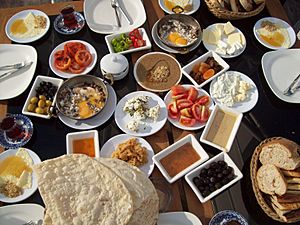
In Turkish cuisine, a typical breakfast includes bread, cheese (beyaz peynir, kaşar), butter, olives, eggs, tomatoes, cucumbers, jam, honey, and kaymak (clotted cream). Sucuk (spicy Turkish sausage), pastırma, börek, simit, poğaça, and soups are also eaten for breakfast in Turkey. A common Turkish breakfast specialty is menemen, made with tomatoes, green peppers, onion, olive oil, and eggs. Various soups (çorba) are also very common and traditional for Turkish breakfast. Mainly chicken broth, lentil soup, and a national delicacy, tarhana soup (a dried cereal food mixed with stock or water) are the most well-known. Tripe soup, trotter soup, and sheep's head soup are also traditionally very common all over Turkey for breakfast. The Turkish word for breakfast, kahvaltı, means "before coffee." However, after World War I, when the Ottoman Empire lost its coffee-producing lands, tea became the everyday hot drink in Turkey instead of coffee. In the Sirkeci district of Istanbul, Pide bread is a popular morning meal.
United Kingdom and Ireland's Full Breakfast

In the United Kingdom, the classic breakfast has been the "full breakfast." This includes fried, scrambled, or poached eggs with bacon and sausages. It usually comes with mushrooms, tomatoes, baked beans, fried bread, black pudding or white pudding, and toast. A healthier version uses grilled meats and poached eggs instead of fried. The "full Scottish breakfast" often uses beef sausages or haggis instead of pork sausages. At its largest, it has eggs, square sausage, fried dumpling, potato scone, tomato, mushrooms, bacon beef links, and fried bread. This full breakfast started in the British Isles during the Victorian era and is one of the most famous British dishes around the world.
Another traditional British breakfast is porridge, which has been a main food in Scotland since the Middle Ages. The breakfast cereal Scott's Porage Oats was first made in Glasgow in 1880. Before American-style breakfast cereals became popular in the early 1900s, dried bread soaked in hot milk or tea, and porridge (boiled oats) were common daily breakfasts. Leftover vegetables (often cabbage) and potatoes from the night before were often re-fried; this became 'bubble-and-squeak'. In Ireland, this dish is called colcannon. Traditionally, breakfast would include a small amount of fruit, like a slice of orange, which was thought to prevent scurvy. Other traditional, but less popular, breakfasts included fish like kippers (smoked herring) with poached egg and toast, and kedgeree (a Scottish-Indian dish with smoked haddock, egg, and rice). Most British breakfasts are eaten with tea, coffee, or fruit juice.
Today in the UK and Ireland, a weekday breakfast might be a cereal dish like muesli, porridge, or cereal, or toast spread with jam or marmalade. Tea and coffee are still very popular drinks. Marmalade, which originally came from Portugal, was a popular British spread for the evening. But the Scots moved it to the breakfast table in the 1700s.
In Old English, breakfast was known as morgenmete, meaning "morning meal."
Hotel Breakfasts
A continental breakfast in UK and Irish hotels usually includes baked goods (fresh bread, toast, pastries like croissants or pain au chocolat), slices of cheese and cold meat, cereal, yogurts, fruit, and drinks like coffee, tea, or fruit juices. While this is the traditional breakfast in parts of continental Europe, elsewhere these breakfasts are common mainly in hotels (especially budget hotels without a restaurant, as they need little preparation).
Breakfast in the Middle East and North Africa
Arab Countries' Quick Meals
Breakfast in Arab countries is often a quick meal. It usually consists of bread and dairy products, with tea and sometimes jam. Flat bread with olive oil and za'tar (a spice mix) is also popular.
Egypt's Ful Medames
Most Egyptians start the day with a light breakfast. Ful medames (a dish of cooked fava beans), one of Egypt's national dishes, is typical. It's seasoned with salt and cumin, and topped with vegetable oil. You can also add tahini, chopped parsley, chopped tomato, garlic, onion, lemon juice, and chili pepper. It's often served with a boiled egg. People scoop it up with the main bread, a whole wheat pita called Eish Masri or Eish Baladi. It usually comes with taʿamiya (the local version of falafel made with fava beans), fresh homemade French fries, and various fresh or pickled vegetables (called torshi). Several kinds of cheeses are popular. Fried eggs with pastirma (cured meat) are also common breakfast foods in Egypt.
Morocco's Morning Breads
For breakfast, many Moroccans eat bread, harsha (semolina griddle cakes), or msemen (oiled pancakes) with olive oil, tea, and different kinds of Moroccan crepes.
Iran's Breakfast Traditions
Breakfast in Iran generally includes different kinds of flatbread like barbari, taftoon, sangak, lavash, white cheese, butter, jam and marmalade (morabba), honey, clotted cream (sar sheer), nuts, and fresh or dried fruits. People drink black tea or coffee. Often, breakfast can be as simple as butter and jam on bread with tea. Iranians prefer to drink their hot black tea with sugar. Traditional cooked dishes for breakfast include haleem (wheat and chicken/lamb/turkey porridge eaten with cinnamon) or kale pache (sheep's feet, stomach, and other organs), adasi (green lentil soup), fried/boiled/soft-boiled eggs, and omlet (eggs cooked in tomato sauce).
Israel's Diverse Breakfast
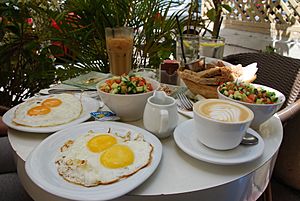
The Israeli breakfast is a mix of food styles from Eastern Europe, farming traditions, North African cuisine, and Levantine cuisine. It usually has a variety of cheeses, sliced vegetables, scrambled eggs, and bread. It's served with spreads like butter, jam, or honey. The most common vegetables are cucumbers, tomatoes, and red bell peppers. Carrots, onions, and radishes might also be included. Cheeses include at least cottage cheese, quark or fromage blanc, and a local type of gouda. Often, Tzfatit and labneh are also served. Side dishes like pickled olives and herring might also be offered. Typical Middle Eastern mezze (small dishes) such as Israeli salad, hummus, tehina, and baba ghanoush, as well as Shakshouka and various salads may be served. The meal is most often served with coffee, tea, and orange juice.
Israeli hotels usually offer this type of breakfast as a buffet. Restaurants might have a pre-set "Israeli Breakfast" menu. A typical Israeli meal can be either dairy- or meat-based, but not both. Only certain types of meat are considered kosher (allowed to be eaten according to Jewish law).
Breakfast in North America
Mexico's Spicy Mornings
A traditional Mexican breakfast includes eggs prepared in different ways (like Huevos rancheros). These are served with beans with chile and tortillas. Also very traditional are chilaquiles (pieces of corn tortilla with cheese and a chile sauce) and entomatadas (a spicy enchilada variation).
Canada and the United States' Breakfast Choices
Breakfast in the United States and Canada often includes hot or cold cereals, eggs, breakfast meats, and quick breads like pancakes, waffles, or biscuits. Different versions of the full breakfast and continental breakfast are also common. Coffee is a popular drink, as is tea, both widely consumed in Canada during breakfast. Orange juice, tomato juice, and other fruit juices are drunk by people of all ages. In the United States, 65% of coffee is drunk during breakfast hours. Milk is also widely consumed, either plain or with flavors like chocolate or strawberry. The average time people start breakfast is around 8:12 a.m.
In the Southeastern United States, grits and biscuits and gravy are popular breakfast foods.
In many areas across the country, the bagel, a ring-shaped bread, is a common breakfast item. A bagel often has seeds, like sesame or poppy, or other spiced toppings. It's usually sliced in half, toasted, and spread with butter or cream cheese or other toppings.
Across the United States, breakfast sandwiches are a common choice for the first meal of the day. A typical breakfast sandwich has egg, cheese, and cooked breakfast meat like bacon or sausage, on a roll. However, regional variations are common. In New Jersey, bacon is often replaced with a processed meat called Pork Roll (also known as Taylor Ham). Other areas change the bread: in New York, the bagel is often used instead of a roll, and in the South, the biscuit is the popular choice. A different version of the classic breakfast sandwich is the breakfast burrito, which comes from Southwestern and Tex-Mex cuisines.
Another popular breakfast item in the United States is the doughnut. This is often eaten by itself, though it's usually served with coffee.
Breakfast in Oceania
Australia and New Zealand's Morning Meals
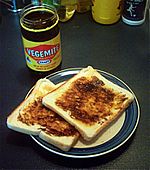
Before World War II and when refrigerators became common, the traditional Australian breakfast was grilled steaks and fried eggs. This was because beefsteak was easy to get back then. While this is still eaten in the countryside, very few city Australians today would remember this breakfast. However, the steak-and-eggs breakfast is still a custom for the United States Marine Corps before landing, because the Marines copied it from Australian soldiers during the Pacific War.
Most city Australians today eat store-bought cereal with pasteurized milk or yogurt, and toast with spreads like marmalade or vegemite for breakfast. Two of the most common cereals are cornflakes and a type of wheat biscuit called Weet-bix. Fruit is also common at breakfast, either on the cereal or eaten separately. While not unusual, a cooked breakfast is more likely to be eaten on weekends or for special occasions, either at home or at a café. A cooked breakfast can include sausage, bacon, breakfast steaks, mushrooms, tomato, hash browns, and pancakes, similar to both British and American cooked breakfasts. Breakfast habits differ more between age groups or families than between cities.
Breakfast in New Zealand is very similar to Australian breakfast. There are many types of processed breakfast cereals, and children often eat those with added sugar. New Zealanders, especially in winter, often eat a hot oat cereal called "porridge". Porridge is usually served with milk, sugar, fruit, or yogurt. Sliced bread that has been toasted and topped with preserves or spreads is another common breakfast. Eating breakfast at a restaurant was rare until the 1990s. However, cafes that serve breakfast until midday or all day are now common. The Big Breakfast is a main item at cafes, similar to the British cooked breakfast, but it rarely includes black pudding. Other common menu items are: eggs cooked how you like, eggs benedict, beans on toast, pancakes, cereal and yogurt, and smoothies. Breakfast almost always includes coffee, tea, or both, with children drinking milk either on their cereal, in a glass, or hot milo. There have been recent concerns about the cost of milk and some families not being able to afford it.
New Zealand McDonald's restaurants offer a "kiwi big breakfast" which includes two sausages, hash brown, scrambled eggs, toasted muffin, and a choice of a small Filter coffee, Hot chocolate, or tea. Some groups, like the New Zealand Red Cross, provide breakfast to children in primary schools who are from poorer families. A 2013 survey found that almost half of all New Zealanders skip breakfast at least once a week, and almost a third skip it up to three times a week.
Fiji's Island Breakfasts
In traditional Fijian villages, breakfast might be tea served with milk and sugar, and food made from flour. This includes tovoi or babakau (a type of fried dough), pancakes, bread, or biscuits with butter. Sometimes a starchy food, like cassava, taro in coconut milk, or rice, is served instead. Leftover fish or meat from the previous night's meal might also be served. Tea made from lemon leaves (called draunimoli) and fruits like pineapple, banana, papaya, plantain, and watermelon are also sometimes served. In city homes, tea and cereals are often eaten. Breakfast foods eaten by Fiji Indians often include a vegetable curry with roti and sometimes differ from the above. Fijians living in Rotuma sometimes eat nuqa fish in tarotaro (fermented coconut yogurt), with fresh tropical fruits.
Breakfast in Sub-Saharan Africa
Breakfast in Africa changes a lot from one region to another.
Nigeria's Diverse Breakfasts
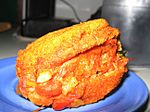
Nigeria has over 250 different ethnic groups, each with their own unique foods. For the Hausa of northern Nigeria, a typical breakfast includes kosai (fried cakes made from ground beans) or funkaso (wheat flour soaked for a day, then fried and served with sugar). Both of these cakes can be served with a porridge and sugar called koko. For the southwestern Yoruba people, one of the most common breakfasts is Ògì—a porridge made from corn, usually served with evaporated milk. Ògì is eaten with Acarajé (akara) or Moi moi. Both are made from ground bean paste; akara is fried in oil, and moi moi is wrapped in leaves or foil and then steamed. Ògì can also be steamed in leaves to make it harder and eaten with akara or moi moi for breakfast. English tea or malta (a soft drink) is served as a breakfast drink. Another popular option in southwest Nigeria is Gari, which is eaten like a cereal. Gari, known in Brazil as farofa, is made from the root of cassava. For breakfast, it's soaked in water and sweetened with sugar.
Senegal's Morning Drinks
Breakfast in Senegal typically includes café Touba, which is spiced coffee with a lot of sugar, sometimes with dried milk. Or, people drink kinkeliba tea. Small beignets (fried dough) and fresh fruit, like mangoes and bananas, are often part of a simple breakfast. These are served with baguette bread and various spreads: Chocoleca, a Nutella-like spread made from peanuts; butter; or processed mild cheese.
Somalia's Canjeero
Breakfast (quraac) is an important meal for Somalis. They often start the day with some style of tea (shaah). The main dish is usually a pancake-like bread called canjeero or canjeelo. It's similar to Ethiopian injera, but smaller and thinner. It might also be eaten with a stew (maraq) or soup. Lahoh is a pancake-like bread from Somalia, Djibouti, and Yemen. It's often eaten with honey and ghee (clarified butter), and washed down with a cup of tea. For lunch, lahoh is sometimes eaten with curry, soup, or stew.
Uganda's Porridge and Katogo
In Uganda, most tribes have different foods, but the most popular breakfast dishes are Porridge and Katogo. Porridge is made by mixing maize flour or millet flour with water and boiling it. Katogo is made from matoke (green bananas), peeled and cooked in the same pot with a sauce (like Beef, peanuts, beans, or greens). Katogo is served with tea or juice. Both dishes are popular all over Uganda.
Images for kids
-
A croissant, often eaten in France and Western Europe.
-
Idli and sambar - a south Indian breakfast.
-
An airline meal for breakfast during a Thai Airways flight.
-
A family breakfast in the Isan region of Thailand.
-
A Sausage, egg, and cheese breakfast sandwich.
-
Head cheese with bread.
-
Pancakes topped with butter and honey.
-
Indian poori with side dishes.
See also
 In Spanish: Desayuno para niños
In Spanish: Desayuno para niños


